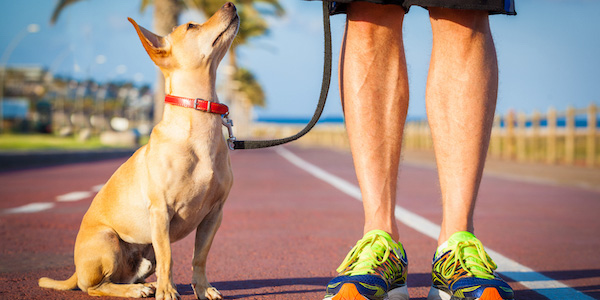
Does your dog know sit? This classic dog behavior is often the first thing people want to teach their dogs. Not only is it the most common cue other people will ask your dog to do when greeting them on the street, but it's a great skill to build up your pup's impulse control and prevent unwanted behaviors like jumping on people or door dashing.
Read on for easy steps to teach your dog to sit when asked. We'll talk about two different ways you can train this behavior, and when it can be helpful in building other training skills.
Beyond just the how-to's, learn why asking a dog to sit might not be the best idea depending on the circumstances, and what to do instead.
How to Train Your Dog to Sit
You can teach any dog to sit, no matter their age! Puppies as young as six weeks can catch on to this behavior, and older dogs without mobility problems can also learn to sit when asked. For really bouncy or high-energy puppies and dogs, often the capturing method explained further below works best. Otherwise, the luring method is a great place to start. You can use both of these methods at the same time, or just stick with the one you're most comfortable with.
What You'll Need:
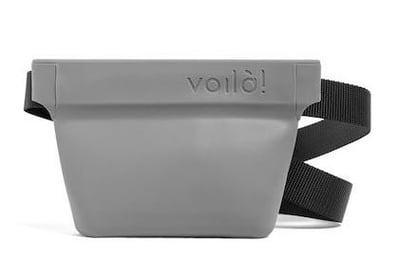 A training treat pouch. My favorite and the one I use the most is the Voilà Ultimate Treat Pouch. It's high-grade silicone, which makes it easy to wash and perfect for the fresh high-value dog treats I use the most. Use code PV10 to get 10% off!
A training treat pouch. My favorite and the one I use the most is the Voilà Ultimate Treat Pouch. It's high-grade silicone, which makes it easy to wash and perfect for the fresh high-value dog treats I use the most. Use code PV10 to get 10% off!- Your clicker (or marker word like "yes!" if you're not using a clicker)
- Your dog's favorite training treats (like these Zuke's Mini Naturals training treats or low-fat string cheese or turkey hotdogs cut up into tiny pieces.
Teaching Your Dog to Sit
Luring a Dog Into a Sit Position
The lure method is often the easiest for most dog owners to start with. A lure is using something your dog wants, like a treat or a toy, to guide them into the desired position. The motion you make when luring your dog into a sit will become smaller with practice and eventually become the hand signal for your dog's sit. The goal is to be able to fade out a lure and fade out food treats in your dog's training.
- Step One: Hold a small training treat in your hand (or between your fingers if you're working with a smaller dog).
- Step Two: Place the hand with the treat very close to your dog's nose so they can smell you've got something yummy!
- Step Three: Slowly move your hand from your dog's nose towards their forehead. They will most likely follow the hand with their nose, causing them to lower their backend to the floor.
- Step Four: Once their rear hits the floor, click and give them the treat while they're in the sit position!
- Step Five: Repeat!
- Step Six: With practice, your dog will anticipate what you're asking for when you start to move the lure. When you notice your dog's sits happening more quickly and not needing the full lure, it's time to move on to adding the verbal cue and fading out the hand lure.
Watch this video to see what luring a sit looks like:
Adding a Verbal Cue for Sit
- Step One: First, make sure your dog is "getting" the sit behavior with just the hand lure. If not, practice this more before adding the verbal cue.
- Step Two: Before you use the lure movement, say "sit." Lure your dog into their sit, then click and treat as you have been doing.
- Step Three: Repeat! With repetition, your dog is making the association of the word "sit" with the action of sitting. You're naming the behavior for your dog.
Fading Out the Hand Lure for Sit
Do a little sit "quiz" with your dog. There's no wrong answer here, it's just to get an idea if your pup has made the association between the word and the action. Stand completely still with no lure or hand signal in front of your dog. Say "sit" just once. Your dog will either:
- Sit: If they sit, click and treat! Give them lots of praise!
- Not Sit: If they don't sit, that's okay! Try giving them a smaller version of the lure to encourage them to sit. Go back to the adding a verbal cue steps for more practice before quizzing again.
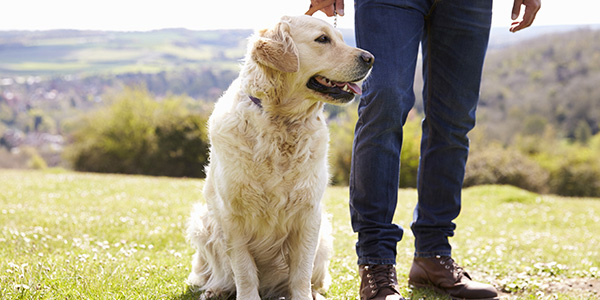
Practice Your Dog's Sit in Different Places
Once your dog is responding to just the verbal cue to sit, it's time to take your practice out and about! Try asking your dog to sit in different rooms of your home, outside in the yard, or while on a walk. This is called generalization of a cue.
Keep using treats as a reward for your pup while adding distractions to your training. It can be hard for your dog to concentrate when there's lots of activity (like a squirrel) around them. Treats are usually the easiest way to get and keep their attention.
PRO TIP: If your dog doesn't sit when asked because they are too distracted, simply add distance between you and the distraction before trying again. Your other option is to increase the value of the treat reward (or consider using toys and play as a reward if your dog finds that more motivating).
Start to Fade Out Training Treats
While you continue practicing your dog's sit, you can begin to phase out the use of training treats. I love using real-life rewards for a dog that sits when asked — such as opening the door to go outside for a walk, or greeting them and giving them scratches and praise when they sit. Sometimes I'll practice when playing fetch or tug, rewarding the sit with another throw of the toy or engaging in more tug.
Read my article "Be a Slot Machine: How to Fade Out Food Treats in Dog Training" to learn more about the process of dog training without treats.
Want to add in stay to your dog's sit? It's easy! Find out how in "How to Teach Your Dog to Stay."
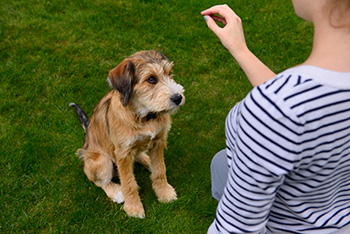 Troubleshooting a Lured Sit
Troubleshooting a Lured Sit
What if your dog keeps jumping instead of sitting for the treat? This is usually because the lure is being held too high above or far away from their nose. If they jump up instead of sitting, lower your hand and try to keep it nice and close to their nose while they're in a standing position.
What if your dog backs up instead of sitting? This also is often due to placement and movement of the luring hand. If you move that hand too quickly, many dogs will back up. Try to move your luring hand slowly and smoothly from their nose to their forehead.
What if your dog isn't interested in the lure? Consider if you're using a treat that's motivating enough for your dog. You can change to a higher value training treat, or try again when they might be more hungry. I often will switch to the capturing technique explained below if I'm working with a dog that's not interested in lures.
Capturing Your Dog's Sit
Capturing a behavior is different from luring as we're not guiding our dog into position with our hand. We actually don't have to do anything other than pay attention to what our dog is doing! Capturing is like taking a picture of the behavior with our clicker, then treating. Your dog will learn that sitting makes you click, and chooses to keep offering a sit in order to get a click and a treat.
- Step One: Have your clicker and treats ready.
- Step Two: Whenever your dog offers a sit on their own, with no prompting from you, click!
- Step Three: Every click gets a treat — toss the treat a few steps away from your dog so they have to move out of the sit position to get it. This resets them so they can offer another sit!
- Step Four: Repeat!
Watch this short video clip from Delighted Dog Training and Canine Insights showing capturing a sit in action (she's using the marker word "good" instead of a click):
Once your pup has that lightbulb moment and begins obviously offering a sit to make you click, it's time to add in the verbal cue. Following the same steps as outlined above in the lure method, simply say the word "sit" as your dog is sitting, click and treat. You can then move on to practicing in different environments and begin phasing out your clicker and training treats.
Troubleshooting a Captured Sit
What if your dog never offers a sit on their own? If your dog doesn't choose to sit on their own, it might be a sign they aren't comfortable in that position or are in pain. If your veterinarian has ruled out pain or another medical issue, you can always use the luring method instead.
What if my dog pops up out of their sit when they hear the clicker? This is expected at first since we're tossing the treat away from them to reset for the next repetition. As your dog makes the association between the action of putting their rear on the floor with the click, you can begin waiting to click until they hold the position for a second. Then click and toss the treat. This is also how you build the stay behavior into your dog's sit.
How to Use Your Dog's Sit Cue in Real Life
Sit is a great alternative behavior to teach your dog, as it's impossible to do unwanted behaviors at the same time as sitting. Your dog can't be jumping on you or other people if their rear is on the floor! They can't be pulling on the leash if they're sitting next to you. Or dashing through an open door if they're in a well-trained sit-stay.
It's also a wonderful way for your dog to communicate that they want something. Many dogs who have learned to sit in a positive training system begin to use it as a way to say please.
- "Please give me some pets."
- "Please give me that piece of chicken."
- "Please let me outside into the backyard."
- "Please grab this toy and play with me."
Having a polite way for your dog to get your attention and otherwise interact with you means they won't be demand barking or otherwise nudging or pawing at you.
Here are just a few ideas of when your dog's sit behavior will be useful:
- Greetings when you arrive home
- Waiting patiently at the door to go on a walk while you put on their harness and leash
- Getting to greet other people while on walks
- When you stop to chat with a friend or neighbor while on a walk
- When your dog is getting weighed on the scale at the vet's office
- Entering doorways so your dog doesn't drag you through
When Sitting Just Isn't Necessary
If Sitting Causes Pain

Many dogs are hesitant to sit or respond slowly to the cue because it hurts. It might be moving into the position that hurts or the pressure of actually sitting. Their pain could be due to injury, obesity, arthritis, or another medical condition. If your dog has a painful condition or injury, don't ask them to sit. If your dog is sitting slowly, is stiff in their movement to sit or get up from a sit, or hesitates when you ask them to sit, visit your veterinarian to find out if they are in pain. Your veterinarian can help you begin a treatment or pain management plan.
Dogs are experts at hiding pain — if you aren't sure whether your dog might be hurting, learn more about what signs to look for in "How Can I Tell If My Dog Is In Pain?"
If pain makes it hard for your pup to sit, speak with your veterinarian about what positions seem the most comfortable for your dog to rest in. Train your pup on a comfortable yoga mat or their orthopedic dog bed. Don't ask them to change positions much during training sessions, instead focus on small training tricks such as touching a hand target. Remember, sit isn't a required dog training skill — standing or laying down is also just as good if you need a stationary behavior from your dog.
PRO TIP: If your dog is hesitant to sit, it could be due to impacted or infected anal glands — especially if they had done these things easily before, but are suddenly less inclined to do so. Read more in our article "Anal Glands — Why Dogs Have Them & What To Do When They're a Problem."
If Sitting is Uncomfortable for Your Dog
I'm going to tell you a secret — I have never asked my Corgi to sit. Having watched her most of her life, she doesn't choose to sit much of the time. Instead, she'll usually settle into a down position when she's not standing or walking around. And when she does choose to sit, it's usually with a rolled hip and with her little "turkey legs" (as we call them at home) sticking out. I want my dog to be comfortable, especially as she's aging into her senior years, and if she's never shown she's comfortable in a sit position, why would I ask her to do it? When I need her to take a stationary position, I ask for a down or a stand-stay instead.
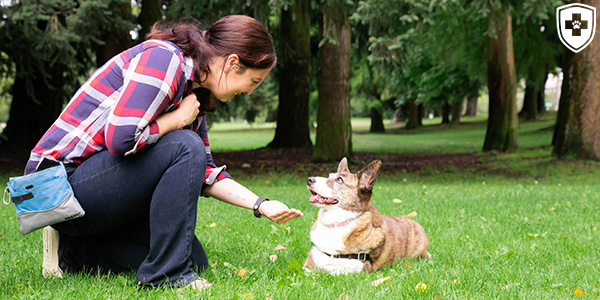
In some cases, the surface you're asking your dog to sit on might be cold or wet. This can be uncomfortable for many dogs, but especially those that don't have thick fur (like Chihuahuas or Greyhounds). Take into account where you're asking your dog to sit and if it will be comfortable for them to do so. Sometimes a slick surface, like tile or hardwood floors, can make it uncomfortable to stay in a sit, since their paws start to slip. Look around for a carpeted or non-slip area and ask your dog to sit there instead. And remember — sit is not a required dog training skill! If your dog feels more comfortable and does better with their down cue or a simple stand behavior, you can always click and treat for those.
What do you use your dog's sit cue for the most? At the door before going on a walk? Mealtimes? Greeting people? Is sit a part of your dog's training repertoire or do you prefer a different stationary behavior? Let us know in the comments below!





